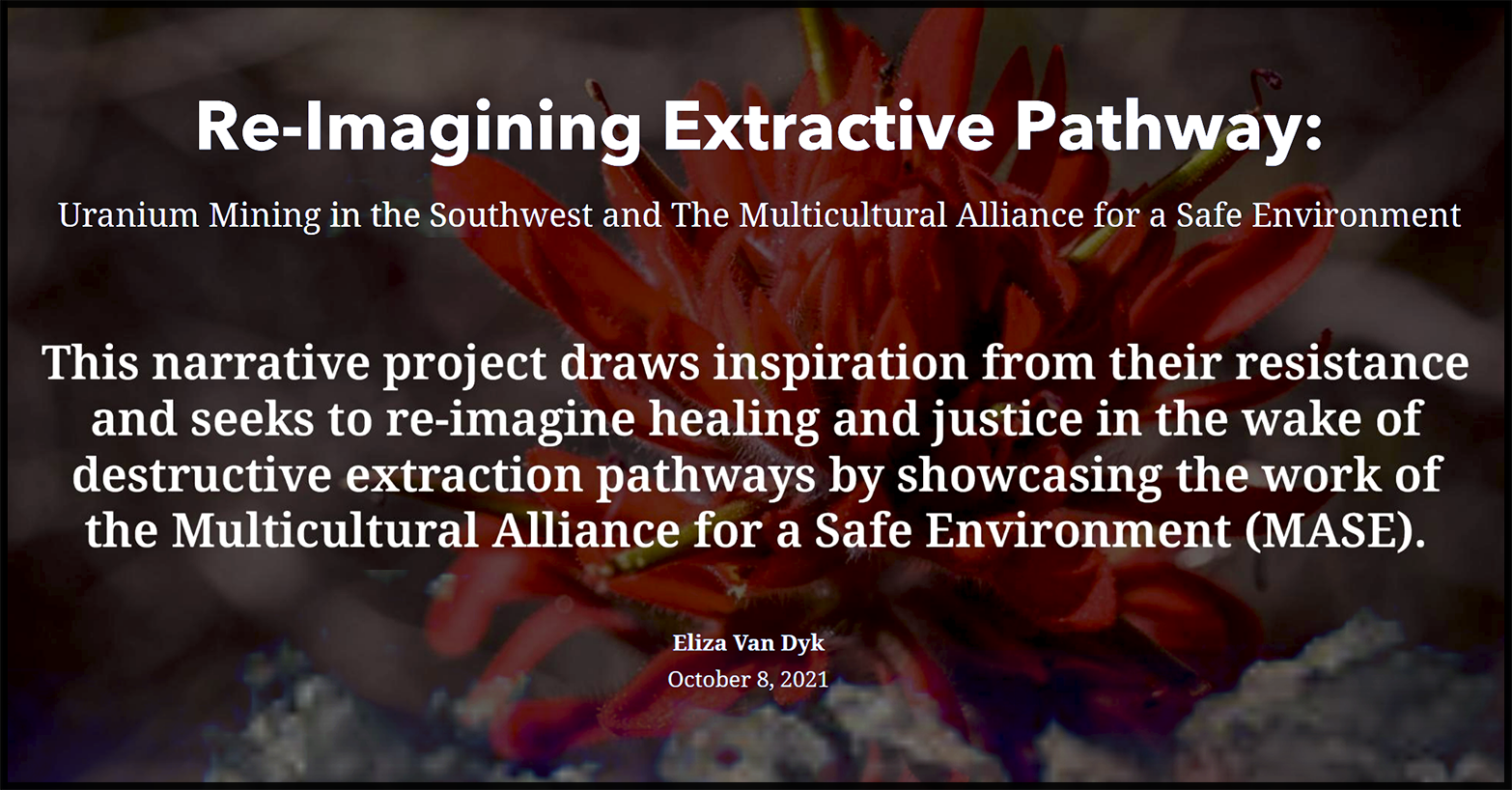New York Times Covers Mt. Taylor, References MASE
Sacred N.M. Mountain Remains at Center of Uranium Fight
By APRIL REESE of Greenwire
Published in The New York Times: August 18, 2011
GRANTS, N.M. — With Mount Taylor looming in the distance, western New Mexico citizens, elected leaders, environmental groups and tribal members clashed at a hearing before state regulators last night about whether a mining company should be allowed to further delay cleaning up a dormant mine on the mountain that may or may not reopen in the next few years. The mountain, located about 15 miles northeast of here, is held sacred by many tribes and pueblos in the Southwest, including the Navajo Nation, the Hopi tribe, and Acoma, Laguna and Zuni pueblos. It also holds the nation’s largest uranium deposit. Rio Grande Resources Corp., a subsidiary of San Diego-based General Atomics, applied last year for renewal of its 2005 standby permit for the Mount Taylor mine, which has remained shuttered since 1990. The new application (pdf) marks the second time the company has sought to renew the permit, which allows it to put off remediating the site with the understanding that the mine will reopen at some point. Under New Mexico’s mining laws, standby permits must be renewed every five years, for a maximum of 25 years. More than 8 million pounds of “yellow cake” were produced from the mine before it was closed more than two decades ago due to plummeting uranium prices. Rio Grande Resources, which acquired the mine from Chevron in 1991, estimates that more than 100 million pounds of uranium remain unplumbed. At the hearing, held by the New Mexico Mining and Minerals Division, testimony was divided roughly equally between those who support the renewal of the company’s five-year standby permit, with an eye toward the local economic benefits that could come from reopening the mine, and those who oppose it out of concerns that contamination could worsen if the site remains un-remediated for another five years. Joe Lister, who manages the Mount Taylor mine site for the company, said there is a high likelihood that the mine will reopen within the next few years, and therefore it makes sense to receive an extension of standby status. State law requires mining companies seeking standby permits to show they are likely to resume mining operations. But Eric Jantz, an attorney with the New Mexico Environmental Law Center, which requested the hearing, noted that the New Mexico Environment Department has found elevated levels of nitrates and uranium in an old underground waste lagoon at the mine site, and expressed concern that delaying a comprehensive cleanup could put the environment further at risk. ‘Everybody’s fighting for survival’ Others warned that jobs and financial gains should not come at the expense of ecological health. “Everybody’s fighting for survival — we need that economic viability,” Steve Juanico of Acoma Pueblo told the hearing officer. “But it’s short lived. … We really need to protect our water resources. Are we doing the right thing?” Lister said the company has worked with the New Mexico Environment Department to develop an abatement plan to address contamination in the lagoon, which involves planting salt cedar trees to soak up contaminated water. The trees will then be uprooted and destroyed. But Lister also acknowledged that salt cedar, while efficient at absorbing nitrates, is unproven as an absorber of water-borne uranium. The mine site is being closely monitored, and no problems have been found beyond the contaminated water in the underground lagoon, Lister noted. State Sen. David Ulibarri (D), who represents the city of Grants in the state legislature, testified in favor of the standby permit renewal, which would allow the company to bring the mine back online quickly. “The mine has proved to be a safe site for many years,” he said, adding that reopening the mine has “tremendous potential for bringing economic viability back” to western New Mexico. Cibola County Commissioner Pat Simpson, speaking as a resident, said he also believes the company should receive a new standby permit, and hopes the mine will resume operations soon. But to some area residents, the cultural significance of the site outweighs any economic benefits the mine could bring. Nadine Padilla of the Multi-Cultural Alliance for a Safe Environment urged regulators to deny the permit on both environmental and cultural grounds. “We’re not only concerned about the quality of the environment and possible contamination of the site; we’re also concerned because it’s a sacred place, a place that tribes regard as holy,” said Padilla, who is of Navajo and Pueblo ancestry and grew up nearby. Acoma and other area pueblos and tribes successfully petitioned the state to permanently designate the upper part of the mountain a “traditional cultural property” in 2009. The designation, which does not cover the existing mine, allows tribes to have greater input in development decisions on Mount Taylor, but it does not prohibit development. Market uncertainty When and if the mine opens also depends in large part on the notoriously volatile uranium market, which was further disrupted by this year’s nuclear reactor meltdown at Fukushima, Japan following that country’s devastating earthquake and tsunami. While uranium prices had risen before the Fukushima disaster, they are currently below levels that would allow the mine to operate at a profit, Lister said. But he said he expects the mine to become economically viable within the time frame covered under the new permit. “We expect the long-term market in uranium to continue to improve, and we expect in this 5-year term to resume operations,” he said. He declined to say what price would trigger reopening the mine, or how much it would cost to resurrect it. Despite recent moves by China and Germany to nix planned nuclear power plants, there is still growing worldwide demand for uranium, Lister added, especially as uranium from old weapons stockpiles is depleted. “The world market is much larger than those countries that canceled their new nuke plants, and we’re seeing interest continue to grow,” he said, responding to a question about global demand in the wake of the Japan disaster. But critics noted the company already received one renewal of its standby permit, in 2005, based on the same argument that resurrection of the mine was imminent. Michael Jensen of Amigos Bravos, a New Mexico-based environmental group, noted that uranium prices skyrocketed during the previous standby permit period, yet the company did not reopen the mine. “I find it hard to believe that we can honestly take them at their word that they really want to get this mine going,” he said during his testimony. No danger? Mount Taylor lies within the Grants Mineral Belt, which helped make New Mexico one of the country’s primary uranium-producing states from the 1950s through the 1980s. But many miners have fallen ill in subsequent years, and they link their health problems to either direct radiation exposure from working in the mines or from the impacts of mining-related contamination. But Lister said that today, the mine site does not pose a threat to the environment or to human health, and officials note that if the mine reopens, it will have to meet modern environmental and health standards. Lister tried to allay critics’ concerns by touting the company’s containment and monitoring program, and he noted that just last May, the state environment department wrote a favorable letter to the mining and minerals division that helps clear the way for the standby permit’s renewal. According to Rio Grande Resource’s permit application, stormwater, which the application says contains “low levels of radioactive contaminants,” is contained with diversion ditches and a network of underground pipes that discharge the water into an evaporation pond. And while there is a 15-acre waste rock pile at the site, “there is no indication the rock pile is any danger to humans or wildlife,” according to the application. “I’ve lived here my whole life and I plan to die here,” Lister said during the hearing. “I’m just concerned about water as everybody else. We should take the opportunity to develop that resource.” Click here (pdf) to read Rio Grande Resources’ standby permit application. Reese writes from Santa Fe, N.M. Copyright 2011 E&E Publishing. All Rights Reserved.





